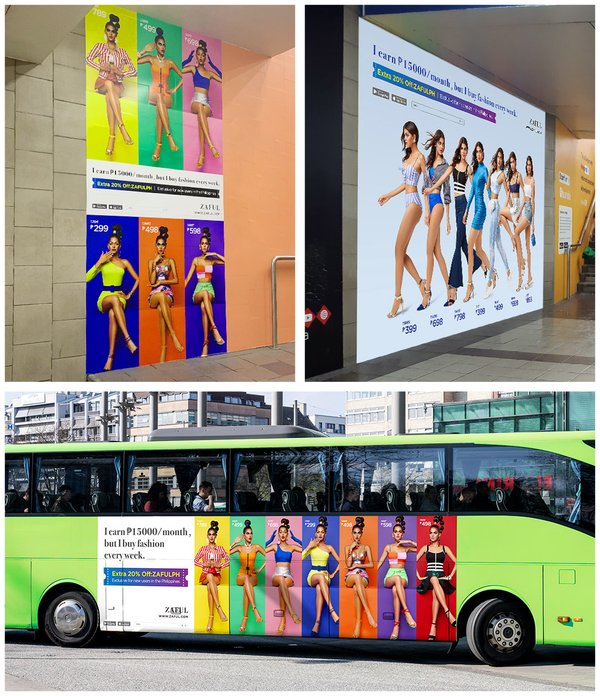A Comprehensive Exam of the Approaches and Strategies for Effective Transportation Marketing Campaigns
Transportation marketing campaign offer a special chance for brands to involve with diverse target markets in vibrant environments. To achieve success, it is vital to understand the subtleties of target demographics, carry out ingenious design approaches, and select optimal placement areas. Furthermore, the effectiveness of these campaigns can be considerably boosted by carefully checking efficiency metrics and adjusting techniques as necessary. As we explore these vital elements, it becomes clear that the path to an impactful transit advertising technique is both intricate and satisfying, increasing the concern of exactly how finest to navigate these intricacies for maximum brand name exposure.
Comprehending Target Demographics
Understanding target demographics is crucial for the success of transportation advertising projects (Transit Advertising Philippines). Determining specific target market segments enables advertisers to customize their messages effectively, making sure that the content reverberates with the desired viewers. This approach boosts engagement and takes full advantage of return on investment
To successfully evaluate target demographics, online marketers have to consider a number of vital factors, consisting of age, income degree, lifestyle, and profession choices. For example, a campaign focused on young professionals may concentrate on benefit and modernity, while one targeting family members could emphasize safety and dependability. Furthermore, geographic elements such as metropolitan versus country setups can significantly affect customer actions and choices.
Information collection techniques such as surveys, emphasis groups, and social networks analytics supply useful insights right into market patterns and consumer behaviors. By leveraging this information, advertisers can craft compelling stories that align with the values and demands of their target audience.
Ultimately, understanding target demographics not just informs the tactical direction of transportation ad campaign yet additionally makes sure that sources are designated effectively. This targeted method increases the probability of accomplishing campaign objectives, cultivating brand name commitment, and driving conversions.
Imaginative Style Techniques
Reliable interaction with target demographics counts greatly on ingenious creative design methods en route ad campaign. To successfully catch attention in a jampacked visual environment, developers need to prioritize quality and visual impact. Making use of high-contrast elements and bold colors can enhance exposure, guaranteeing that messages are easily understandable from a distance.
Incorporating vibrant imagery that reverberates with the target market is important. Visual storytelling strategies can stimulate emotions and produce memorable associations with the brand. In addition, calculated use typography aids convey necessary information quickly; clear font styles and ideal dimensions better enhance readability.
Integrating interactive components, such as QR codes or increased fact attributes, can involve travelers past easy monitoring (Transit Advertising Philippines). These methods not just advertise user communication however additionally bridge the gap in between typical marketing and electronic involvement
In addition, utilizing area artistically-- whether on bus covers, transit shelters, or metro ads-- can result in innovative layouts that damage the mold of conventional advertising. By welcoming imaginative creativity while maintaining brand consistency, campaigns can cultivate a solid connection with their audience, ultimately driving both awareness and activity. The assimilation of these style methods is paramount for accomplishing successful transportation advertising and marketing results.
Strategic Placement Methods
Optimizing the influence of transit advertising and marketing depends upon strategic positioning techniques that guarantee optimal presence and interaction. Effective positioning involves understanding and examining high-traffic locations traveler demographics to identify the most helpful areas for advertisement displays. For example, positioning ads near entryways and leaves of transit lorries can catch the attention of boarding and alighting travelers, hence improving exposure.
Moreover, making use of both external and indoor surface areas of transit automobiles can considerably expand reach. Outside ads, noticeable throughout commutes, engage pedestrians and various other chauffeurs, while indoor ads target travelers in a restricted environment. Furthermore, positioning advertisements in transportation centers, such as bus terminals or train terminals, allows for boosted impacts as travelers transition between various settings of transportation.
Timing is additionally important; straightening the campaign launch with peak travel periods optimizes target market involvement - Transit Advertising Philippines. Additionally, leveraging digital screens in transportation settings can facilitate dynamic content, boosting and giving real-time updates user communication. By employing these calculated positioning techniques, marketers can make sure that their transportation marketing campaign achieve optimal exposure, resonate with the target market, and ultimately drive wanted outcomes

Measuring Campaign Performance
To examine the success of transportation marketing campaign, it is important to utilize a range of measurement techniques that provide insights into target market involvement and general efficiency. One main technique is using essential performance indications (KPIs), such as reach, impacts, and engagement prices, which measure exactly how numerous individuals connected and checked out the advertisement with it.
Surveys and emphasis groups can also contribute in gauging customer understandings and recall, allowing online marketers to recognize the effect of their messaging. In addition, tracking web site traffic and social networks involvement throughout and after the campaign helps gauge straight actions to the marketing.
Another efficient technique is making use of location-based analytics, which try this web-site can supply data walking traffic around certain transportation places, providing understandings into whether the campaign effectively captured the interest of travelers. Moreover, analyzing sales data can reveal relationships between transportation advertising and enhanced revenue, supplying substantial evidence of a campaign's effectiveness.
Instance Studies of Success
Understanding the efficiency of transportation advertising and marketing projects via dimension techniques lays the groundwork for analyzing real-world examples that illustrate successful results. By utilizing geo-targeted digital ads and Go Here analytics, the brand measured a 30% increase in sales in regions where the wraps were prominently displayed, showing the straight effect of transit marketing.
Another engaging instance originates from a regional nonprofit organization that launched a campaign on metro systems to advertise an area event. The company incorporated vivid visuals with QR codes directing commuters to a registration web page. Post-campaign evaluation exposed a 50% rise in event presence contrasted to the previous year. The use of straight interaction through technology amplified the project's reach and performance.

Final Thought
In summary, effective transit marketing projects necessitate a detailed method that incorporates an understanding of target demographics, innovative style strategies, and calculated positioning. By focusing on emotional involvement through bold visuals and maximizing visibility throughout optimal travel times, brand names can dramatically boost their impact. Additionally, recurring dimension of project effectiveness through essential efficiency indications and consumer feedback guarantees constant renovation. Jointly, these strategies foster brand existence and make the most of the roi en route advertising and marketing campaigns.
Comprehending target demographics is vital for the success of transportation marketing campaigns.Effective communication find here with target demographics depends heavily on ingenious creative layout strategies in transit advertising and marketing campaigns. By using these tactical positioning techniques, marketing experts can make certain that their transportation marketing campaigns achieve optimal presence, resonate with the target audience, and eventually drive desired end results.
Comprehending the efficiency of transit advertising and marketing campaigns with measurement strategies lays the groundwork for checking out real-world examples that highlight successful outcomes.In recap, successful transportation advertising and marketing campaigns demand a thorough technique that integrates an understanding of target demographics, innovative style techniques, and critical placement.